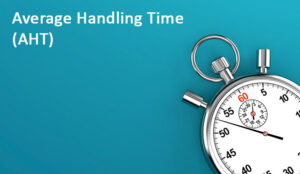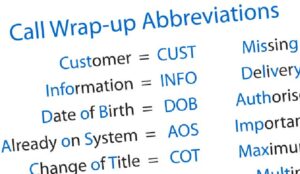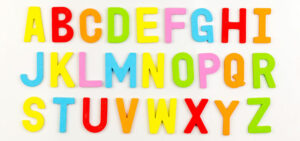In contact centres, advisors juggle customer conversations, system navigation, and follow-up actions, all while maintaining the quality of service that customers expect.
Yet, the part of the interaction customers don’t see, known as wrap time, can quietly add up, eating into efficiency and inflating Average Handling Time (AHT).
Wrap time is often overlooked because it happens after the call ends, but it plays a crucial role in both operational performance and advisor workload.
In this article we define wrap time, explain why it matters, and share great ways to support your team to reduce it to help contact centres strike the right balance: reducing unnecessary delays while protecting advisor well-being and data accuracy.
What is Wrap Time?
Wrap time, otherwise known as “wrapping-up time” or “wrap-up time”, is the time spent by a contact centre advisor doing after-call work (ACW) once they have concluded an interaction.
When the call is over and the customer is no longer involved, wrap time is still considered part of the interaction, as the advisor is still working on the customer’s query. It is therefore factored into Average Handling Time (AHT).
The ACW that advisors will be doing in wrap time includes logging contact reasons and outcomes and scheduling follow-ups and similar actions, as well as updating other team members.
How to Calculate Wrap Time
Before we share some great ways to lower wrap time, and consequently AHT, without pressuring advisors, we need to know how to calculate and track wrap time.
The Wrap Time Formula
To calculate wrap time you need to divide the ‘Total Wrap Time’ by the ‘Number of Calls’, as shown in this formula:
Wrap Time = Total Wrap Time ÷ Number of Calls

Yet, while we can do this manually, trace reports should give the wrap times automatically, across different advisors and contact reasons.
While it will be difficult to track one or two individual examples of long wrap times, as they will vary largely due to the nature of the call, these reports will provide you with an average wrap time for each advisor.
By having averages for each advisor, you will gather information as to which individuals may be struggling to log and schedule their actions or those just looking for an extra little break.
Why Is Wrap Time Important?
Wrap time can be an important metric in a call centre as it helps to identify the proportion of an interaction that is customer-facing.
While AHT is a measure of your total investment of time, separating wrap time shows the customer’s investment of time.

Wrap time is a measure that many contact centres look to lower, in the hope of reducing overall AHT without negatively influencing the customer’s experience directly, as the customer is not involved.
The benefit to lowering AHT is that we can better maximize our service level, but we need to be careful in how we do this, even with wrap time…
5 Ways to Reduce Wrap Time
Now we know what impacts wrap time, you will likely already have some ideas for how to lower it in your contact centre, without pressuring advisors.
But just in case you are still looking for some inspiration, here are five ideas that we would recommend for lowering wrap time while positively impacting the advisor experience.
1. Complete Some ACW During the Contact
Advisors can be trained to handle portions of their ACW while on the call, particularly during moments when customers are occupied, such as looking for information. This strategy reduces post-call workload without impacting call quality.
For instance:
- Log customer reasons in real time: Update the CRM with call reasons while on the call.
- Take live notes: Capture key details during the interaction, especially for complex calls. These notes can then be quickly refined after the call.
Although not all ACW can be completed during the interaction, these practices minimise the cognitive load of recalling actions post-call, thereby reducing Wrap Time.
2. Teach Advisors to Use Abbreviations
Using abbreviations is a proven method to speed up written communication – and it can work wonders in reducing ACW times in contact centres.
For example, advisors can use:
| Abbreviation | Meaning |
|---|---|
| CUST | Customer |
| DOB | Date Of Birth |
| FONE | Telephone |
| @ | At |
| < / > | Less Than / More Than |
Ensure these abbreviations are standardised and included in a style guide to avoid confusion. Training on their proper use helps agents adopt this method efficiently, enabling faster documentation.
For more abbreviation ideas, read our resource article: Call Centre Abbreviations to Speed up Wrap Time
3. Look to Technology to Automate ACW
By building robotic process automation (RPA) into your CRM system, you can reduce call wrap time by automatically filling in required fields in customer data or call records.
RPA takes away the admin from the advisor, allowing them to focus on delivering a positive customer experience.
RPA can send automated messages to departments or customers after a call, to save advisors from manually updating colleagues and customers while taking large chunks off your wrap time.
4. Speed Up Your Computer System
Slow computer systems are a significant factor in long wrap-up times. Modern CRM systems, however, can automatically log call details using keyword recognition, greatly reducing manual effort.
These systems can also allocate a predefined amount of wrap-up time after each call, maintaining consistency across the floor.

Additionally, improving screen recording technology can reveal where agents face difficulties during After Call Work (ACW).
“By looking at screen recordings, and also listening to the talk time beforehand, supervisors can identify if advisors need additional training or if there are other problems affecting their performance and ACW times,” adds Frank Sherlock, VP International at CallMiner.
5. Put an End to Wrap Time Misuse
Occasionally, some advisors may misuse Wrap Time for personal tasks, such as checking sports scores or sending personal messages, under the guise of updating records.
To prevent this:
- Monitor With Tools: Screen recordings and trace reports can help identify misuse patterns.
- Set Alerts For Prolonged Wrap Time: Supervisors can act when patterns deviate significantly from expected norms.
- Identify Underlying Issues: Prolonged wrap time misuse might indicate an advisor struggling with ACW, requiring additional support or training.
Rather than setting strict Wrap Time targets, communicate to advisors that performance reviews include a breakdown of handling times. This discourages misuse and fosters accountability.
Why Should We Be Careful Before Looking to Reduce Wrap Time?
Ensuring adequate wrap time between calls has two key benefits. The first is in ensuring the data that advisors are entering into the contact centre system is reliable, while the second is in removing pressure that might negatively influence performance.
Building on this second point, let’s consider the impact on the quality of overall work if advisors are stressed by the fast pace of calls.
So, the key to reducing wrap time in a call centre is to do so without pressuring advisors, so we don’t impact the quality of their output or their morale. We have to keep an eye on balancing advisor needs against call volumes.
Keeping this balance is much easier said than done, and it may be easier to allow advisors to self-monitor, or to enforce constraints only for limited periods of high volume.
What Impacts the Length of Wrap Time?
There is no industry standard for wrap time in a call centre, with there being a wide variability between different centres.
But why is this?
Well, there are number of factors that influence how long an advisor takes to complete their ACW, and below we have four examples of why your wrap times may be longer or shorter than other contact centres.
Contact Centre Technology and Self-Service
Faster systems and automation reduce advisors’ After-Call Work (ACW), but effective self-service removes simple queries, leaving advisors with more complex tasks that can increase talk and wrap times.
Sector and Contact Type
Wrap time varies by sector and contact type, with more complex calls, like in technical support, leading to longer wrap times compared to simpler transactional calls in retail.
Internal Processes
Requiring advisors to log extra details, like updating knowledge base content or submitting review requests, can significantly extend wrap time.
Advisor Behaviour
While some advisors may just be new or slower at typing, there will likely be those that see wrap time as a time to gain an extra few moments before being made available for another contact.
For more on reducing other parts of your contact centre’s handle times, read our articles:
- How to Safely Knock 20 Seconds Off Your Average Handling Time (AHT)
- How to Reduce Hold Time in Your Contact Centre
- 49 Tips for Reducing Average Handling Time (AHT)
Author: Charlie Mitchell
Reviewed by: Hannah Swankie
Published On: 8th Apr 2020 - Last modified: 19th Aug 2025
Read more about - Call Centre Management, After Call Work (ACW), Average Handling Time (AHT), Brent Bischoff, Business Systems, CallMiner, Frank Sherlock, Management Strategies









































